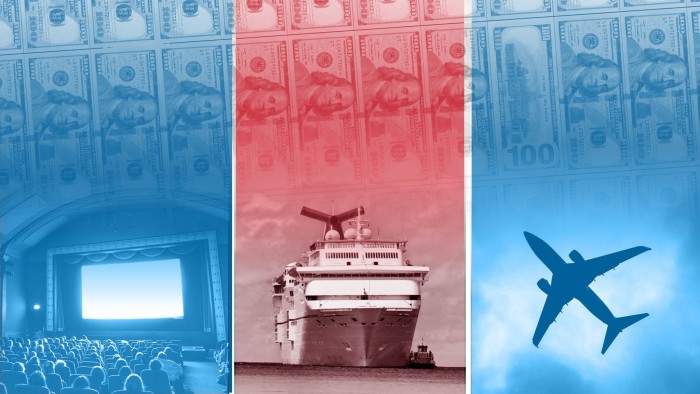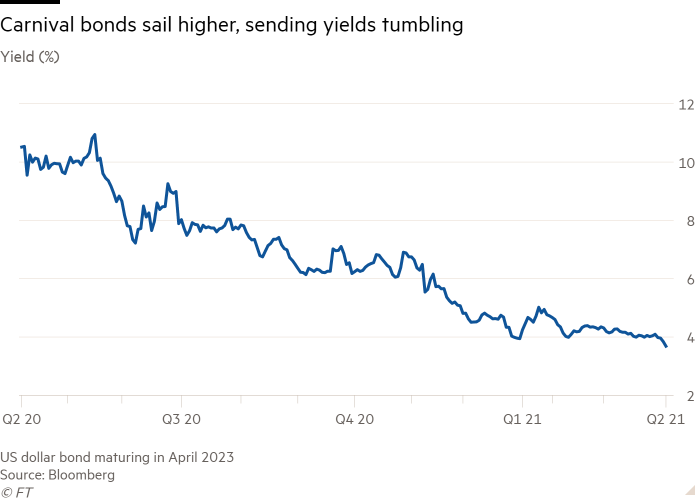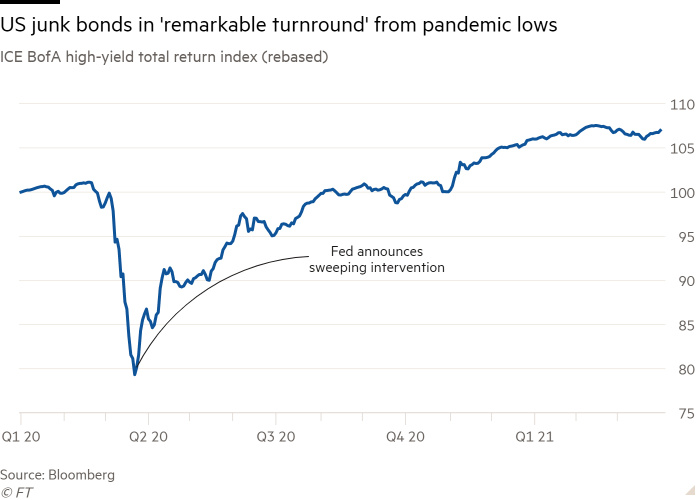Investors scoop up huge returns from companies’ crisis-era bonds

Roula Khalaf, Editor of the FT, selects her favourite stories in this weekly newsletter.
Bonds issued by some of the companies hit hardest by coronavirus have rallied vigorously over the past year, rewarding investors who were prepared to gamble they would survive.
Cruise operator Carnival Corporation is, again, a prime example. One year ago, it pawned its ships to borrow $4bn from investors demanding an 11.5 per cent interest rate. Now the yield on those bonds has dropped to below 4 per cent as the bonds jump in value.
Carnival is still burning through $600m per month. The ships used as collateral for the bond deal are still docked while the company waits for a US ban on cruises to lift. But buyers of these bonds, and of debt issued by cinema chains and airlines, have made huge returns over the past 12 months as an economic recovery has taken root.
“It is astonishing,” said Shannon Ward, a portfolio manager at Capital Group, an asset manager that invested in multiple bonds issued at the time and owns nearly 10 per cent of the Carnival bond, according to recent regulatory disclosures. “Back then in April last year there were a whole lot of questions about how these companies could make it. Issuing bonds into that uncertainty you had to put a hefty coupon on it . . . It was a very difficult time.”

US high-yield bonds, which are rated lower than their investment-grade counterparts, have returned more than 23 per cent to investors for the 12 months to the end of March, more than erasing the steep losses from last year’s sell-off, according to an index compiled by ICE Data Services.
It is only the third time in history that the rolling 12-month return for the market has exceeded 20 per cent, according to analysts at Deutsche Bank. The other two periods were after the global financial crisis in 2008 and the dotcom bust at the turn of the century.
Investors and analysts point to the historic intervention by the Federal Reserve, which announced on March 23 2020 that it would take the unprecedented step of buying corporate bonds to support the market, for orchestrating the turnround.
As debt prices began to rebound last year, restaurant group Yum Brands, which owns brands including KFC and Taco Bell, broke a three-week hiatus for high-yield bond sales, raising $600m at a coupon of 7.75 per cent.
The company was, and remains, among the higher-rated issuers in the high-yield market, but a wave of closures to its restaurants had pushed it to seek emergency financing.
The bond now trades close to 110 cents on the dollar.

Higher up the ratings ladder, investment-grade companies have already begun refinancing bonds issued last year, taking advantage of investor demand and lower borrowing costs.
Kohl’s this week raised fresh debt with a coupon of 3.4 per cent that will go towards redeeming a $600m bond sold last April at a coupon of 9.5 per cent. The crisis-era bond has since risen to trade at 130 cents on the dollar, or a yield of below 2 per cent.
It follows a similar move from department store chain Nordstrom last week when it raised $675m to redeem a bond from April.
In total, more than $6tn of investment-grade debt, accounting for over 80 per cent of the outstanding, trades above 100 cents on the dollar, according to an index run by ICE Data Services. In the $1.5tn US high-yield bond market the number is just slightly lower at 79 per cent of outstanding.
“It’s a remarkable turnround,” said William Smith, director of US high yield at AllianceBernstein. The fund manager holds about 3.6 per cent of the Yum bond. “What central banks and politicians have done is compress the cycle. We had an unprecedented shutdown of the economy — one of the worst recessions we have ever seen — and now we’ve already bounced back.”
Some still urge caution.
The funding frenzy since last year has expanded the pool of outstanding corporate debt, increasing refinancing needs down the road and jolting leverage higher.
Exuberance for the economic outlook has also dragged down corporate borrowing costs with the additional yield above US Treasuries for US corporate bonds at historic lows. It means the market is susceptible to rising interest rates as inflation forces take hold. This year, the investment-grade market has suffered one of its worst starts on record and returns in the high-yield bond market have started to come under pressure.
Investors warn that, with so much positive expectation built into the market, the risk for disappointment — which translates to prices falling — is high.
“The question mark is what comes after the euphoria of fiscal stimulus wears off,” said Smith.
Comments